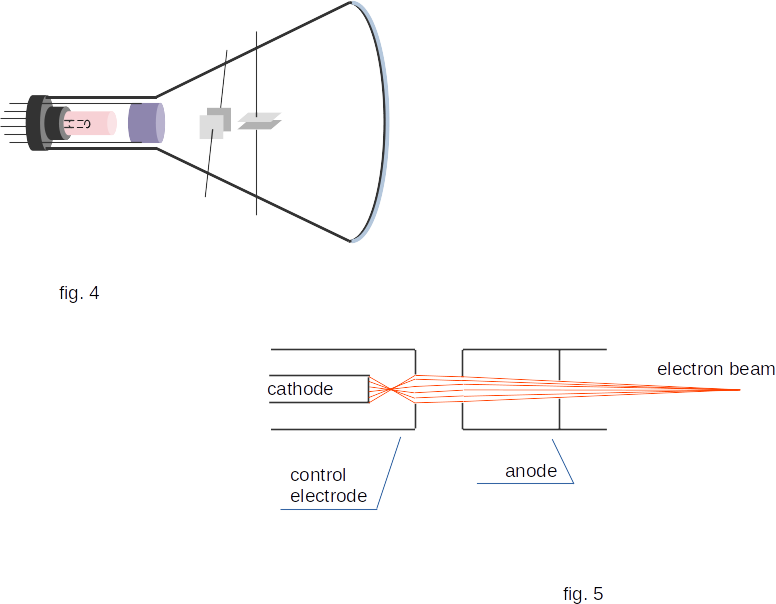From the Electrical current in different environments
114. Electron beam. Cathode-ray tube
If a hole is made in the anode of the electronic tube, some electrons accelerated by the electric field will pass into the hole forming an an electron beam behind the anode. The number of electrons in the beam can be controlled by changing the potential of the grid.
Properties of electron beams and their application.
The electron beam, getting on bodies, causes their heating. In modern technology, this property is used for electronic melting of ultrapure metals in vacuum.
At braking of the fast electrons getting on a substance, there appears X-ray radiation. This property is used in X-ray tubes. Some substances (phosphorus, zinc sulphides and cadmium) glow when irradiated with electrons.
The electron beams are deflected by an electric field. For example, passing between the plates of the capacitor, electrons deflect from a negatively charged plate to a positively charged plate (fig. 1).
The electron beam also deflects in a magnetic field. Flying over the north pole of the magnet, electrons deflect to the left and over the south pole to the right (fig. 2). The deflection of the electron fluxes coming from the Sun in the magnetic field of the Earth to its poles leads to the fact that the glow of gases of the upper atmosphere (polar lights) is observed only at the poles.

The possibility to control the electron beam with the help of electric or magnetic fields and the glow of the screen (covered with phosphorus) under the action of electrons is used in the electron beam tube (cathode-ray tube).
The Cathode-Ray Tube (CRT).
The cathode-ray tube was the main element of TV-set in 1980s and oscilloscope - a device for investigation of fast variable processes in electric circuits (fig. 3).

The mechanism of the cathode-ray tube is shown in figure 4. The tube is a vacuum cylinder, one of the walls of which serves as a screen. At the narrow end of the tube there is an electron beam source - an electron gun (fig. 5). It consists of a heated cathode, control electrode and anode (sometimes there are several anodes). Electrons are emitted by the cathode and pass through a hole in the cylindrical control electrode (it plays the role of a grid - it regulates the number of electrons in the beam). The anode looks like several discs with small holes inserted in a metal cylinder. A potential difference of hundreds or even thousands of volts is created between anode and cathode. A strong electrical field between these electrodes accelerates the electrons and they acquire higher speed. The shape and arrangement of the tube electrodes are chosen so that along with the acceleration of electrons, the focus of the electron beam also occurs, i.e. the cross-section area of the electron beam on the screen is reduced to almost a point.

On its way to the screen, the beam passes sequentially between two pairs of control plates similar to flat capacitor plates. If there is no electric field between the plates, the beam is not deflected and the glowing point is located in the center of the screen. If the potential difference is created on the vertically arranged plates, the beam moves in the horizontal direction, and if the potential difference is created on the horizontal plates, the beam moves in the vertical direction.
By using two pairs of plates at the same time, the luminous point on the screen can be moved in any direction. Since the mass of electrons is very small, they react almost instantaneously to changes in the potential difference of the control plates. This makes it possible to use electron beam tubes in an oscilloscope.
In the cathode ray tube used in television set, the beam created by the electron gun is controlled by a magnetic field. This field is created by the coils placed on the neck of the tube.